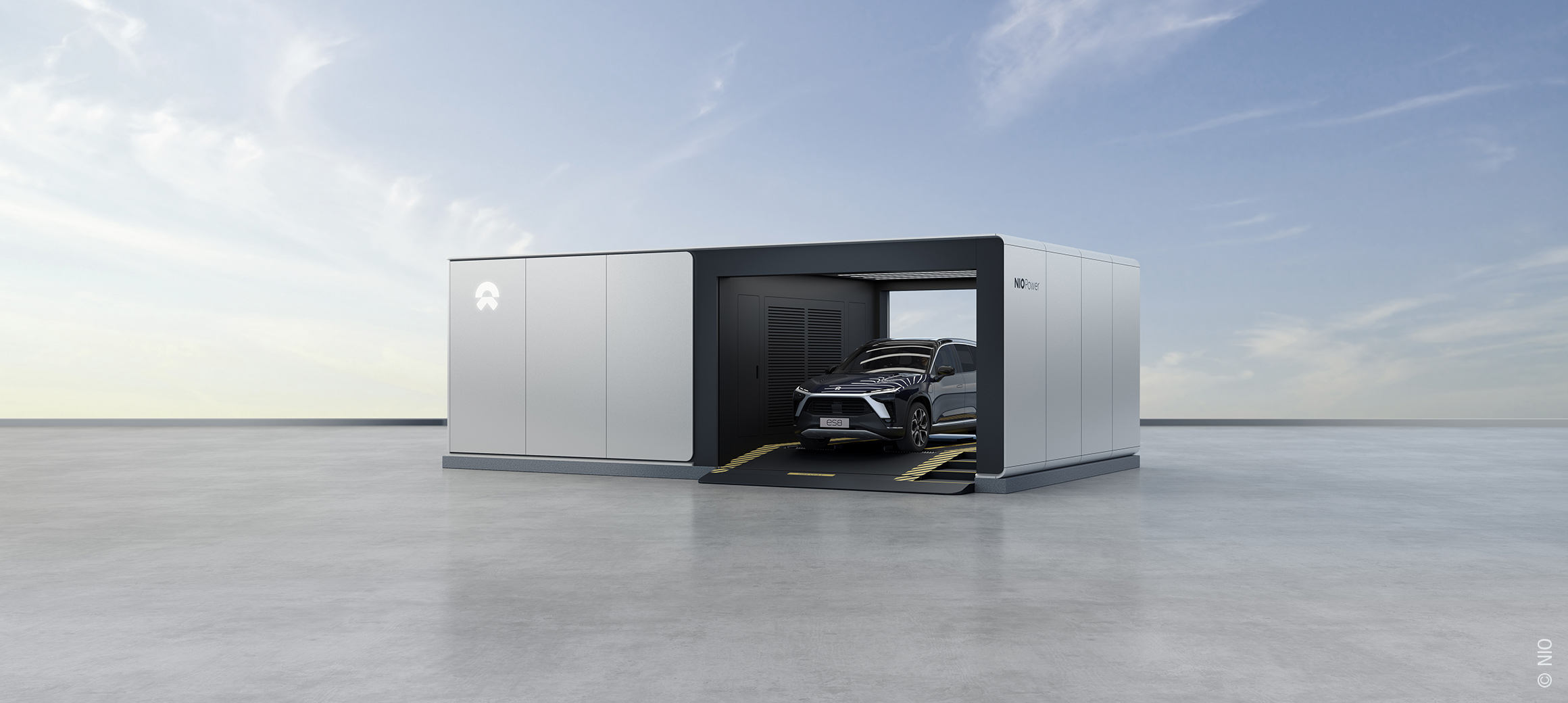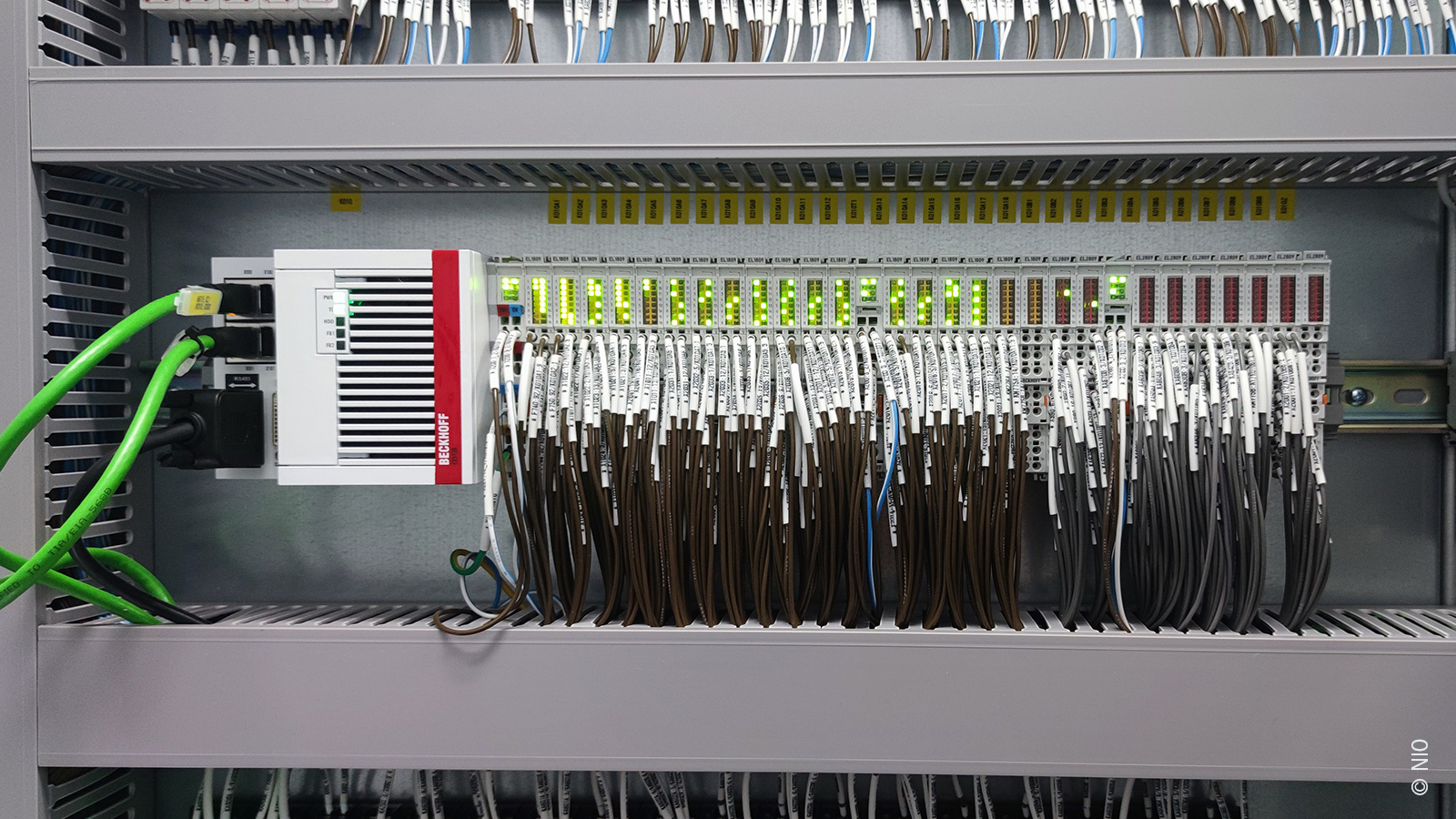

PC-based control and EtherCAT power battery swapping stations for electric vehicles
Chinese automaker NIO aims to provide high-quality smart electric vehicles combined with an optimal customer experience. The NIO Power energy service system also contributes to this. It uses PC-based control from Beckhoff to ensure the safe and efficient operation of NIO's second-generation power swap stations.
Founded in 2014, NIO Inc. is a global supplier of electric vehicles, such as the ES8, ES6 and EC6 SUVs, the ET7 sedan and the ET5 coupe. The offering also includes the NIO Power energy service system, which – based on the NIO Power Cloud – provides a comprehensive service to customers via mobile charging vehicles, charging stations, battery swap stations and roadside service teams. PC-based control technology from Beckhoff is used, with CX5130 Embedded PCs, the powerful TwinCAT 3 software platform, the high-speed EtherCAT fieldbus and the corresponding I/O terminals from the EL series. From NIO's point of view, this technology offers the advantages of standardization, openness and high compatibility, combined with fast and professional technical support. This ensures reliable and efficient operation of the power swap stations.
Battery replacement as an alternative to on-site charging
On-site charging at the vehicle user's home or office is the main method of recharging electric vehicles. However, this usually requires a great deal of time. Moreover, as the share of neighborhood electric vehicles (NEVs) in new vehicle sales continues to grow, particularly in China, consumer concerns about mileage, power recharging and acquisition costs persist. NIO therefore sees battery swapping as an advantageous solution over on-site charging.
NIO is a pioneer and promoter of the battery swap model in China. The company’s electric vehicles were designed from the outset with a battery pack separate from the body. This ensures easy battery replacement, standard battery specifications and the establishment of appropriate battery replacement stations. According to NIO, customers would designate their residences within a 3 km radius of the battery swap station as "Houses in Electric Area." In order to achieve its own target of supplying 90% of customers accordingly by 2025, the charging infrastructure is to be expanded significantly: after building more than 700 battery swap stations by the end of 2021, 600 more stations annually are planned in China from 2022 to 2025. By the end of 2025, the total number of NIO battery swap stations worldwide is expected to exceed 4,000, including about 1,000 outside China.

With more than 1,400 patents, the second-generation power swap stations offer users an optimal charging experience, according to NIO, with complete charging taking only the time it takes to play a single song. Each time the battery is replaced, there is also a self-test with three amperages to check the state of the vehicle and the battery. To do this, the electric vehicle simply needs to be parked on the parking base of the battery swap platform. Following correct placement by a positioning system, the vehicle is raised to a certain height with the help of a lifting device. The swap system retrieves the new battery from the charging platform, moves it under the electric vehicle, performs the battery swap and transports the removed battery to the charging platform. The entire process is controlled and monitored by PC-based control from Beckhoff, with real-time information about the current status of the vehicles and devices also being transmitted to the higher-level cloud service system.
High-performance hardware and software with fast communication
In the second-generation battery swap stations, NIO relies on the CX5130 Embedded PC, the TwinCAT 3 software platform, EtherCAT Terminals and ultra-fast EtherCAT communication. The fanless, DIN rail-mountable CX5130 with dual-core processor processes hundreds of I/O signals and controls the numerous servo axes of the swap station. A 1-second UPS provides reliable backup of persistent data in the event of a power failure. The extended operating temperature range of -25 to +60 °C and the extended storage temperature between -40 and +85 °C enable use even in demanding climates. According to NIO, TwinCAT is characterized by high openness and compatibility with other systems. This allows for use of common database software, which stores the operating data of the battery swap station via TwinCAT Database Server. TwinCAT 3 is integrated in Visual Studio® and supports programming according to IEC 61131-3, via C/C++ and with MATLAB®/Simulink®.
As a modular software platform with PLC and NC PTP functionalities, TwinCAT offers an integrated solution for PLC and motion control on a single embedded PC. This makes the data exchange between motion and logic control faster and more direct. TwinCAT NC PTP supports the standardized PLCopen motion control function blocks, offers numerous functions such as multi-axis coupling and cam plates with up to 255 axes. This makes PC-based control more flexible and powerful than conventional motion controllers, according to NIO. Here, short task cycle times and fast EtherCAT communication ensure the high real-time and synchronization requirements for the numerous servo axes of a battery swap station. TwinCAT Scope View monitors and logs all operating data in real time during the battery exchange process, including servo axis motion profiles, trajectories and torques.
According to NIO, the EL1809 and EL2809 high-density (HD) EtherCAT Terminals enable a very space-saving layout in the control cabinets of the battery swap station. Overall, the wide I/O spectrum from Beckhoff covers all required signal types. As a globally established communication standard, EtherCAT enables the simple integration of third-party components in addition to fast signal acquisition and output via the wide range of interfaces in the Beckhoff I/O portfolio. In addition, there is maximum flexibility with regard to network topology selection as either a line, star or tree architecture.
Conclusions
"There are hundreds of data points to monitor and control in a second-generation NIO battery swap station. Lifting vehicles and removing and installing batteries also requires sophisticated processes, such as multi-axis coupling and torque control, as well as remote uploads and unattended operation," explains Zheng Feifei, Technical Director of NIO Power. "The CX5130 Embedded PC from Beckhoff with dual-core CPU and the standard, modular structure of the TwinCAT 3 software platform deliver the power needed for executing multiple control algorithms and data acquisition for the battery swap station. Furthermore, common database software can be integrated to store high-resolution and high-volume process data from the battery swap. Numerous fieldbus interfaces in addition to EtherCAT, e.g. for Modbus, offer high compatibility and facilitate the integration of third-party devices such as sensors. The update method of the boot program enables easy integration into over-the-air (OTA) systems as well as updates from the cloud without having to reboot the embedded PC. The excellent event logging feature facilitates remote analysis and diagnostics, eliminating the need for our service technicians to visit the customer's site. This saves valuable time and labor costs," concludes manager Zheng Feifei.